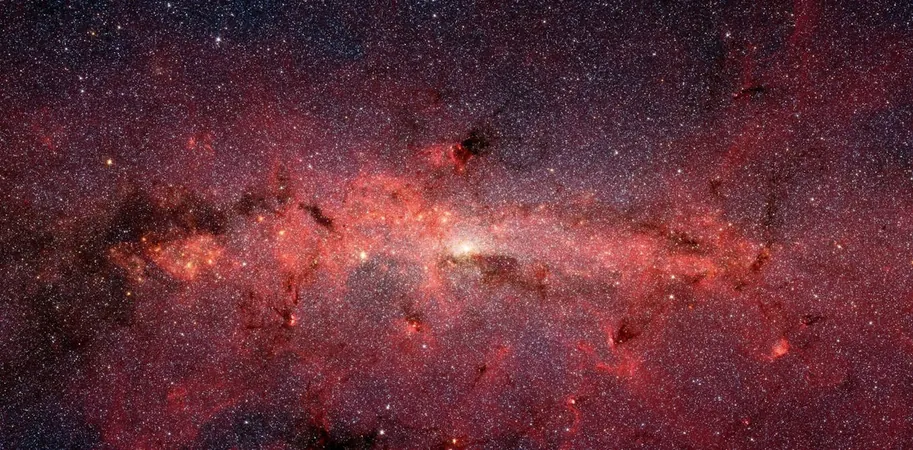
Could a New Form of Dark Matter Finally Solve the Milky Way's Long-Standing Mysteries?
2025-04-16
Author: Sophie
Unlocking Galactic Secrets: The Milky Way's Silent Riddles
For decades, astronomers have been baffled by puzzling phenomena swirling around the core of our Milky Way galaxy. The central molecular zone (CMZ), a dense and chaotic region, exhibits a surprising level of ionisation—where gas molecules lose electrons and become electrically charged. Additionally, an enigmatic gamma-ray glow at 511 kilo-electronvolts (keV) has been detected, leading to a range of theories but no clear answers.
Dark Matter's Hidden Role Revealed?
In a groundbreaking study published in *Physical Review Letters*, researchers propose that these two mysteries may be intertwined and linked to dark matter—a mysterious substance that constitutes approximately 85% of the universe’s total matter but evades direct detection. Rather than the heavyweight dark matter typically sought after, the researchers suggest the existence of a lighter form, potentially unveiling a key to understanding these cosmic puzzles.
A Closer Look at the CMZ
The CMZ spans nearly 700 light years and is densely packed with molecular gas. While it has been established that celestial phenomena like cosmic rays and starlight contribute to its ionisation, they fail to account for the extraordinary levels observed. Similarly, the gamma-ray emissions detected since the 1970s have seen various proposed sources—from supernovas to neutron stars—but none have provided a satisfactory explanation.
The Shared Puzzle of Positrons and Electrons
What if both the ionisation in the CMZ and the 511 keV gamma-ray emissions arise from a single process? Researchers hypothesized that lighter dark matter particles, known as sub-GeV dark matter, could collide with their antiparticles and annihilate, producing electrons and their antimatter counterparts (positrons). These newly formed particles would create the high ionisation rates observed in the gas-rich CMZ by interacting with surrounding hydrogen molecules.
Why This Theory Matters
Their simulations indicate that these interactions might produce similar gamma-ray emissions, thus linking the two phenomena. This fascinating notion not only explains the ionisation but may also begin to unravel the mystery behind the elusive 511 keV emissions.
Testing the Invisible: The Future of Dark Matter Research
The ionisation rate observed in the CMZ provides an innovative method to investigate light dark matter models, which are challenging to detect in laboratory settings. The findings show a surprisingly uniform ionisation profile throughout the CMZ, which stands in contrast to other explanations that require more localized sources.
A Galactic Treasure Trove of Information
Future telescopes equipped with advanced resolution capabilities may help unveil more details about the spatial distribution of gamma-ray emissions in relation to the CMZ's ionisation. Continued monitoring of this region may either bolster or challenge the dark matter hypothesis, paving the way to revealing the fundamental nature of this elusive substance.
As we study the glowing heart of our galaxy, new revelations about dark matter may lurk just beneath the surface, reminding us that the universe is still a treasure chest of mysteries waiting to be uncovered.









 Brasil (PT)
Brasil (PT)
 Canada (EN)
Canada (EN)
 Chile (ES)
Chile (ES)
 Česko (CS)
Česko (CS)
 대한민국 (KO)
대한민국 (KO)
 España (ES)
España (ES)
 France (FR)
France (FR)
 Hong Kong (EN)
Hong Kong (EN)
 Italia (IT)
Italia (IT)
 日本 (JA)
日本 (JA)
 Magyarország (HU)
Magyarország (HU)
 Norge (NO)
Norge (NO)
 Polska (PL)
Polska (PL)
 Schweiz (DE)
Schweiz (DE)
 Singapore (EN)
Singapore (EN)
 Sverige (SV)
Sverige (SV)
 Suomi (FI)
Suomi (FI)
 Türkiye (TR)
Türkiye (TR)
 الإمارات العربية المتحدة (AR)
الإمارات العربية المتحدة (AR)